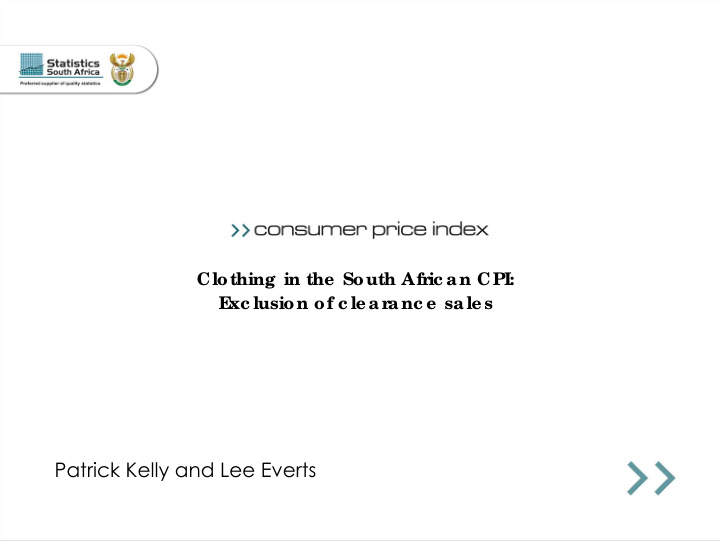



Clothing in the South Afric an CPI: E xc lusion of c le ar anc e sale s Patrick Kelly and Lee Everts
Aim of this pape r To demonstrate a simple method for dealing with clothing prices in absence of quality adjustments
Index 100 120 140 160 20 40 60 80 0 Patte rn of c lothing and footwe ar ove r long pe riod Jan-88 Jul-88 Jan-89 Jul-89 Jan-90 Jul-90 Jan-91 Jul-91 Jan-92 Jul-92 Jan-93 Jul-93 Jan-94 Jul-94 Jan-95 Jul-95 CPI_metro Jan-96 Jul-96 Jan-97 Jul-97 Period Clothing and Footwear Jan-98 Jul-98 Jan-99 Jul-99 Jan-00 Jul-00 Jan-01 Jul-01 Jan-02 Jul-02 Jan-03 Jul-03 Jan-04 Jul-04 Jan-05 Jul-05 Jan-06 Jul-06 Jan-07 Jul-07
Unde rstanding c lothing de flation from 2003 Deflation initially attributed to cheap imports from East Corroborated by anecdotal information from retailers By mid 2006, general inflation accelerating Clothing retailers reporting internal inflation Certain private sector analysts raise questions about validity of continued clothing deflation
Change in pr ic e c olle c tion me thod Pre 2005 •Questionnaires dispatched to retailers (head office) •Chain stores provide one price (average) ― Problem: cannot track regional variations ― No indication of availability •Strict specifications - Woman’s summer blouse, short sleeves, made from 100% synthetic fabric. Post 2005 •Price collectors deployed through the country •Specifications not changed •Specific item identified and described for pricing in future months
T ypic al pr ic ing be haviour ashion/ se asonal ite ms vs non fashion/seasonal items F Seasonal patterns not strong Item comes onto rack at certain price Remains at same price for season (+6 months) End of season: two stages of sales •General price reduction •Final stock clearance Substitute item comes in at higher price (usually)
Colle c tion me thod bias on pric ing tre nds Old method: capturing an average price, will reflect price change when substitute item is introduced New method: tracking specific item, captures entry price, then price drop at end of season New item then initiated and spliced in at same price level as previous item ended Leads to deflationary trend
IL O manual “Sale or special offer prices should be recorded if these are either temporary reductions on goods that are likely to be available again at normal prices or are stock-clearing sales (such as January sales or summer sales). Special purchases of end-of-range, damaged, shop-soiled or defective goods should not normally be priced, as they are likely not to be the same quality as, or comparable with, goods previously priced and are unlikely to be available in future. If the special offer is limited to the first customers, the item should not be priced, as the offer is not available to everyone…. .”
Inte r national pr e c e de nts Many countries require that discounted products be available in adequate quantities to be eligible for pricing and employ quality adjustment techniques Some exclude discount prices if they are not expected to return to normal price
Ne w South Afr ic an pr ac tic e All end of season discounts are considered to be of a permanent nature and with limited availability When an item is discounted then this is recorded by the price collector on the form. The discount price is recorded but is not used in index calculation The following month the price collector receives a form requiring identification of a substitute item
Me thod of introduc tion Change-over introduced in January 2008 Took a conservative (strict) view of principle of non revision of historical numbers Compared 2007 indices 2008 indices Included discounted prices Excluded discount prices Deflationary Inflationary Resulted in steep month on month increase from Dec 07 to Jan 08
Clothing and footwear Footwear Clothing Dec-08 Nov-08 Oct-08 Sep-08 Aug-08 CPI Clothing and Footwear Jul-08 Jun-08 May-08 Apr-08 Mar-08 Feb-08 Jan-08 Period Dec-07 Nov-07 Oct-07 Sep-07 Aug-07 Jul-07 Jun-07 May-07 Apr-07 Mar-07 Feb-07 Jan-07 95 90 85 80 75 70 65 60 Index
Re ac tion to c hange Outcry over the big jump in January Stats SA committed to publishing the extent of upward bias created by the method of introduction Bias calculated by creating a non discounted index for 2007 and comparing difference between change in this, with change in published index
Extent of bias in headline CPI from change in clothing Period Contribution of clothing to all Contribution of clothing to all items % Upward items % y/y y/y bias to all items % y/y from clothing Non-discounted on Non-discounted on non-discounted discounted Jan-08 0,174 0,016 0,158 Feb-08 0,186 0,014 0,172 Mar-08 0,201 0,012 0,189 Apr-08 0,205 0,014 0,191 May-08 0,209 0,014 0,195 Jun-08 0,218 0,011 0,207 Jul-08 0,239 0,018 0,221 Aug-08 0,289 0,025 0,264 Sep-08 0,296 0,024 0,271 Oct-08 0,309 0,029 0,280 Nov-08 0,307 0,028 0,279 Dec-08 0,318 0,035 0,283
Change s to c lothing in 2009 Major changes to many aspects of CPI in 2009 as part of reweighting and overhaul Change in clothing is to move away from many narrow products to few broadly defined categories
Change s to c lothing in 2009 Old de sc r iption Ne w de sc r iption 'BLOUSE - SUMMER - SHORT Blouse SLEEVE/SLEEVELESS - Made from SYNTHETIC FABRIC 'TROUSERS - SUMMER - Made Trousers (excl jeans) - from NATURAL FABRIC business 'CARDIGAN - WINTER - LONG Knitwear SLEEVE It is responsibility of price collector to identify most popular item in particular store
Clothing and footwear (M etro) 105 104 103 102 101 Clothing an d footw ear Index Clothing 100 Footw ear 99 98 97 96 95 Jan -08 Feb-08 M ar-08 Apr-08 M ay-08 Ju n -08 Jul-08 Au g-08 Sep-08 O ct-08 N ov-08 Dec-08 Jan -09 Feb-09 M ar-09 Period
Rental survey hank you T
Recommend
More recommend